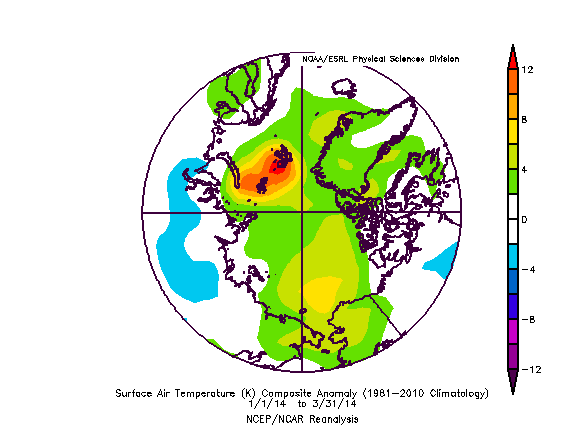Whilst a variety of climate change “skeptics” have been pointing out recently that the April 2014 edition of the National Snow and Ice Data Center’s Arctic Sea Ice News mentioned that:
A large area of the multiyear ice has drifted to the southern Beaufort Sea and East Siberian Sea
which led said skeptics to claim things like:
There is a lot of thick ice in the western Arctic, which will be difficult to melt this summer.
they glossed over the bit where the NSIDC added:
Where warm conditions are likely to exist later in the year.
In fact conditions have been very warm (relatively speaking!) in the Arctic for all of 2014 so far. The DMI daily mean temperature of the Arctic area north of the 80th northern parallel has never dropped below the long term average all winter:

and the surface air temperature anomaly chart for the Arctic for the first three months of 2014 looks like this:

Those anomalously warm temperatures may well have something to do with the fact that the latest PIOMAS Arctic sea ice volume estimates which have just been released reveal this:

As you can see, according to the PIOMAS model at least, Arctic sea ice volume has now reached the second lowest level for the date since the satellite record began.
Whilst the skeptics have been complaining about the amount of ice on the Great Lakes of North America they seem to have somehow failed to notice the anomalously low coverage of snow over Siberia. Here’s the surface air temperature anomaly forecast for the northern hemisphere tomorrow:

Do you see the bright red patch over the coast of the Laptev Sea, indicating temperatures 20 degrees Celsius above normal? Now take a look at a similar chart, but of the surface air temperatures themselves:

That reveals that the temperatures over the edge of the Laptev Sea are forecast to be above the freezing point of fresh water tomorrow. Just in case you’re wondering what the shores of the Laptev Sea look like at the moment, here’s a picture we recorded earlier today, courtesy of NASA Worldview and the MODIS sensor on the Aqua satellite:

What do you suppose the same area will look like in a day or two’s time, or in a month or two’s time for that matter?
In answer to the first part of my question, things are rather cloudy this morning. Here’s a close up of the area in the top right hand corner of the image above. This one is a false colour image using bands 1, 2, and 7 of the MODIS sensor on the Terra satellite. Clouds appear white, snow and ice pale blue, and open water dark blue:
According to Weather Underground temperatures in Tiksi on the Laptev coast are currently around -2 °C:
Wow, “20.0Co > normal”…..you forgot to mention that it still < 0.0C, is spring when temps are highly dynamic, and that ice cover is still OK. Now why would you have over looked that?
Hi Hunter,
I haven’t overlooked anything. I’ve provided links to the data so any interested party, yourself included, can draw their own conclusions.
The temperatures in Tiksi today are merely a topical example of the anomalously high temperatures that have been present Arctic wide all winter. See above!
Anything on the antarctic? And if not, why not? (we are on a 2-pole planet … right?)
What is your affinity to the n. pole only?
Hi Jim,
This site is concerned with “Putting the Arctic sea ice record straight” just like it says at the top. Our mission is to clear up the many mass media misrepresentations of the Arctic sea ice story.
Hence there is no mention of the Antarctic, except of course in the comments and from The Mail on Sunday!
I’m glad you asked about the Antarctic even if it is off the topic of this blog. Unfortunately, Antarctic ice is melting rapidly from below, creating a fresh layer of water around key areas of Antarctica. The freshened water has stopped or reduced the formation of deep water in multiple areas. That’s one reason why the annual sea ice has increased around Antarctica. Read about it on my blog post.
http://www.dailykos.com/story/2014/03/05/1281907/-The-Antarctic-Half-of-the-Global-Thermohaline-Circulation-is-Collapsing
The faltering deep water formation in the Antarctic is allowing more heat to reach the Arctic speeding up the melting there. I hope this answers your question. 🙂
In related news the Siberian Times reports that: